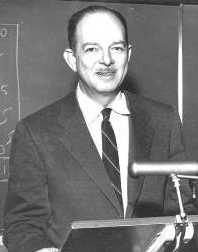Harry Hammond Hess

Harry Hammond Hess (1906 - 1969)
Harry Hess was a professor of geology at Princeton University (USA), and became interested in the geology of the oceans while serving in the US Navy in World War II. His time as a Navy officer was an opportunity to use sonar (also called echo sounding), then a new technology, to map the ocean floor across the North Pacific.
He published ‘The History of Ocean Basins' in 1962, in which he outlined a theory that could explain how the continents could actually drift. This theory later became known as ‘Sea Floor Spreading'.
Hess discovered that the oceans were shallower in the middle and identified the presence of Mid Ocean Ridges, raised above the surrounding generally flat sea floor (abyssal plain) by as much as 1.5 km. In addition he found that the deepest parts of the oceans were very close to continental margins in the Pacific with Ocean Trenches extending down to depths of over 11 km in the case of the Marianas Trench off the coast of Japan.
Hess envisaged that oceans grew from their centres, with molten material (basalt) oozing up from the Earth’s mantle along the mid ocean ridges. This created new seafloor which then spread away from the ridge in both directions. The ocean ridge was thermally expanded and consequently higher than the ocean floor further away. As spreading continued, the older ocean floor cooled and subsided to the level of the abyssal plain which is approximately 4 km deep.
Hess believed that ocean trenches were the locations where ocean floor was destroyed and recycled.
Although his theory made sense, Hess knew, like Wegener, that he still needed convincing geophysical evidence to support it. This was to come just a year after his 1962 publication...
Next pioneer